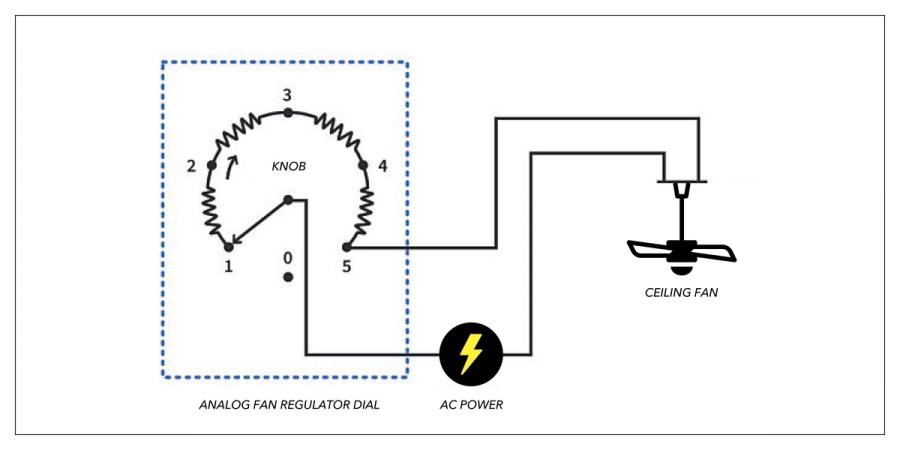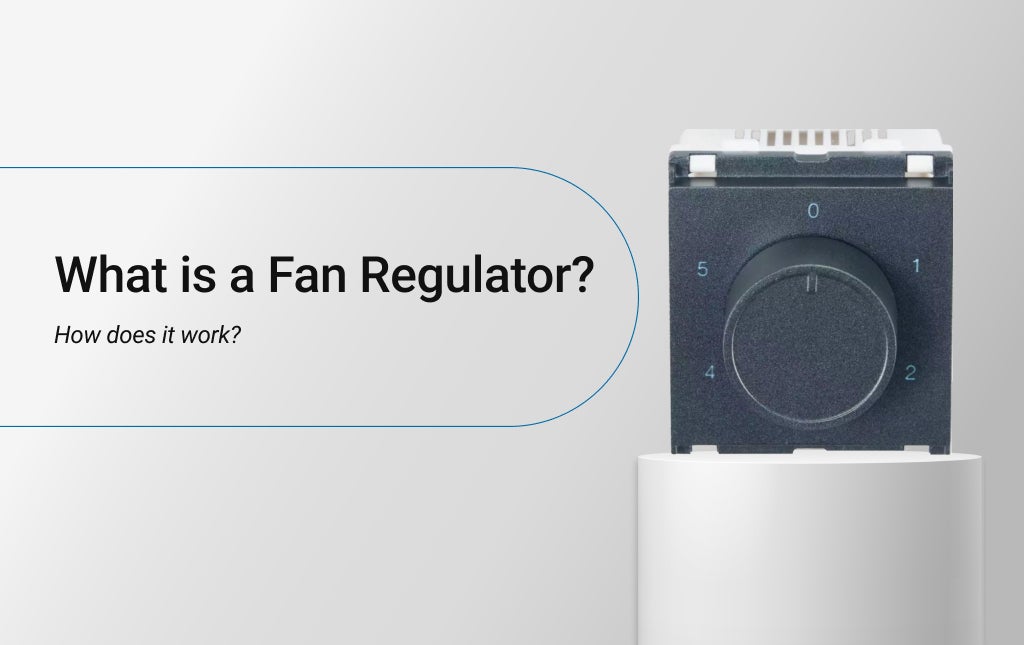What is a Fan Regulator? How does it work?

Ceiling fans are still the staple means of circulating indoor air in most parts of the world, and so are Fan Regulators. From its inception as a basic resistor-based controller to its modern incarnation as a compact electronic device, the fan regulator has undergone quite an evolution. In today's post, we explore the form and function of fan regulators over the years.
Evolution of Fan Regulators
Let's begin at the very beginning, when there was no electricity. Even in those times, rudimentary mechanisms made of pulleys and levers were used to change fan spin. Electrical fan regulators first emerged at the turn of the 20th century. These regulators used variable resistors (such as rheostats) to adjust the voltage supplied to the motor, and regulate its speed.
In the mid-20th century, capacitor-based regulators were developed as more reliable and efficient alternatives. These operated by varying the phase angle of the AC voltage, leading to smoother speed transitions and reduced electricity usage.
Consequently, electronic fan regulators came into being, with solid-state circuitry replacing the mechanical and analog components of earlier devices. These modern fan regulators used pulse-width modulation (PWM) to achieve higher precision in speed control and minimise energy wastage.
And now, in the 21st century, we are seeing fan regulators with connected technologies and automation features, which give us unprecedented control over fan speeds and energy utilisation. These smart fan regulators can be controlled remotely using your smartphone and integrated into smart home systems to be programmed according to environmental conditions and user preferences. Soon, we may also witness sensor-driven and AI assisted home automation technologies that further enhance this seemingly ordinary wiring accessory.
Types of Fan Regulators
Essentially there are only two types of fan regulators that you can buy in the market.
- Analog Fan Regulators: Analog regulators utilise mechanical or electronic components to adjust fan speed.
- Digital Fan Regulators: Digital regulators rely on microcontrollers and digital signal processing to achieve precise control.
Which fan controllers are we using in our homes?
Analog fan regulators are by far the most widely used controller devices. With innovation in technology, these fan speed regulators have shrieked in size while offering improved design and aesthetics. For example, modular fan regulators, like the Englaze Fan Regulator fits in a regular socket bracket and seamlessly melds with your home interiors.
What are Modular Fan Regulators?
Modular fan regulators are analog fan controllers that represent a modern and efficient approach to wiring accessories. These regulators are designed to seamlessly integrate into modular switchboard systems, allowing for easy installation, customization, and expansion. With modular fan regulators, users can mix and match various components, such as switches, dimmers, and sockets to create a custom electrical setup.
The modular design not only simplifies installation but also facilitates future upgrades or modifications without the need for extensive rewiring. Whether it's a residential, commercial, or industrial setting, modular fan regulators offer versatility, reliability, and aesthetics, making them an indispensable choice for modern electrical installations.
How does an analog regulator control fan speed?
An analog fan regulator contains spools of wire with different amounts of resistance. When the knob is set to a particular position, the speed adjusts according to resistance value and the change in voltage supplied to the motor. Higher resistance in the series connection means lower fan speeds and vice versa.

Benefits of using Fan Regulators
Using a fan regulator has benefits like enhanced comfort, greater energy efficiency, and convenience in various settings. Here's a look at the many benefits of a fan regulator:
- Customised Comfort: Fan regulators allow users to tailor airflow to their preferences, providing personalised comfort levels year-round. Whether you prefer a gentle breeze for relaxation or a brisk airflow for cooling, adjustable fan speeds ensure that you can create the perfect atmosphere for any occasion.
- Energy Efficiency: One of the most significant advantages of fan regulators is their ability to conserve energy. By adjusting fan speed to match cooling requirements, you can optimise energy usage and reduce electricity consumption. This efficiency not only lowers utility bills but also contributes to environmental sustainability.
- Noise Reduction: Fan regulators enable quieter operation by reducing fan speed when full power is not needed. Lower fan speeds result in reduced noise levels, creating a more peaceful and comfortable environment for work, rest, or sleep. This is especially beneficial in bedrooms, offices, and other areas where noise pollution can be disruptive.
- Extended Lifespan of Fans: By controlling fan speed, regulators help mitigate wear and tear on fan motors and components, prolonging the lifespan of ceiling fans. Reduced strain on the motor leads to less frequent maintenance and replacement, ultimately saving you time and money in the long run.
- Seasonal Adaptability: In a country like India, fan regulators offer versatility for year-round use, adapting to changing seasons and weather conditions. In warmer months, higher fan speeds provide effective cooling, while lower speeds offer gentle air circulation during cooler periods.
- Improved Air Circulation: Proper air circulation is essential for maintaining indoor air quality and preventing stagnation. Fan regulators promote consistent airflow, helping to distribute conditioned air more evenly throughout the room. This reduces the likelihood of hot spots, stale air, and moisture buildup, creating a healthier and more comfortable indoor environment.
Also Read: Circuit Breaker: Types, Uses, And Applications
Price of Fan Regulators and Replacement Cost
While fan regulator prices in India may vary from brand to brand and retailer to retailer, modern fan regulators are remarkably affordable devices, often costing just a few hundred rupees. With such accessible pricing, upgrading to modular fan regulators is not only practical but also cost-effective. You can easily find a range of options and compare prices at Lauritz Knudsen online or other reputable retailers.
However, it's crucial to emphasise that while the replacement process for modular fan regulators is straightforward, installations should always be conducted by trained personnel or under the supervision of a qualified individual. Working with electrical systems requires knowledge and expertise to ensure safety and compliance with regulations. Therefore, it's imperative to prioritise safety and seek professional assistance when necessary.

